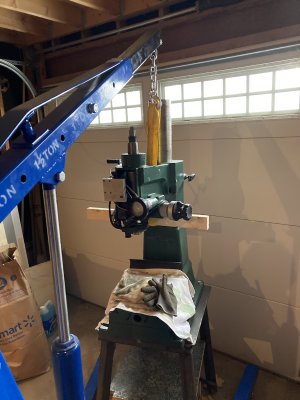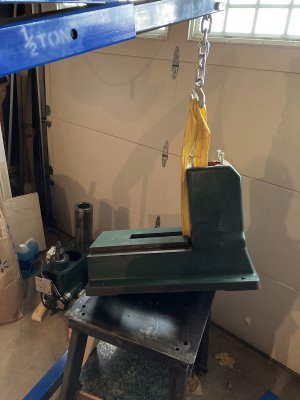trlvn
Ultra Member
We join the story slightly past the beginning. There is a long and boring saga between my purchase of this mill in August 2019* and relocating it to my basement (November 2021). Suffice to say it involved renovations, pandemics, illness, surgery, chemo, recovery and more renovations to get to the present situation. Which is that I need to disassemble the machine into pieces that my son and I can safely transport down the basement stairs.
Since the machine is almost 20 years old, this is also a good opportunity to clean and lube all the hard-to-get-at places. The powerfeed, DRO, X and Y tables and motor have all been removed and deposited in the basement. No pics--all rather straightforward stuff. The previously linked thread explained a little detour driven by the desire to remove the lower portion of the belt cover to enable a safe lift of the head and column off the base. Here is how I lifted it:

@Canadium your hoist is a joy to use. Smooth as silk going both up and down. Dead-nuts simple to pick up the head and column this way.
Since the head is not easy grab securely, it occurred to me that a temporary base under the column might make it possible to lash the unit securely to my 2-wheel cart. Here I've just bolted it onto the bottom of the column before setting the assembly down on the floor.

I haven't done this yet but if it turns out to be dicey, I can always simply lift the head off the column and take them separately.
Since the engine hoist was already there, I also used it to pick the base off the stand:

You can also see the head & column sitting out of the way on the temporary base.
So the next steps are that the head & column, base, and stand all need to get down the stairs. The engine hoist will also be disassembled and go down to help with putting the mill back together. I need the sun to melt today's snow and my son to provide some muscle.
Stay tuned for the next instalment in Trlvn's Terrific Travelling RF30 Tale coming to a web forum near you...
Craig
* I was able to use the mill in the garage by stringing an extension cord from my clothes dryer outlet. Inconvenient but possible.
Since the machine is almost 20 years old, this is also a good opportunity to clean and lube all the hard-to-get-at places. The powerfeed, DRO, X and Y tables and motor have all been removed and deposited in the basement. No pics--all rather straightforward stuff. The previously linked thread explained a little detour driven by the desire to remove the lower portion of the belt cover to enable a safe lift of the head and column off the base. Here is how I lifted it:

@Canadium your hoist is a joy to use. Smooth as silk going both up and down. Dead-nuts simple to pick up the head and column this way.
Since the head is not easy grab securely, it occurred to me that a temporary base under the column might make it possible to lash the unit securely to my 2-wheel cart. Here I've just bolted it onto the bottom of the column before setting the assembly down on the floor.

I haven't done this yet but if it turns out to be dicey, I can always simply lift the head off the column and take them separately.
Since the engine hoist was already there, I also used it to pick the base off the stand:

You can also see the head & column sitting out of the way on the temporary base.
So the next steps are that the head & column, base, and stand all need to get down the stairs. The engine hoist will also be disassembled and go down to help with putting the mill back together. I need the sun to melt today's snow and my son to provide some muscle.
Stay tuned for the next instalment in Trlvn's Terrific Travelling RF30 Tale coming to a web forum near you...
Craig
* I was able to use the mill in the garage by stringing an extension cord from my clothes dryer outlet. Inconvenient but possible.

